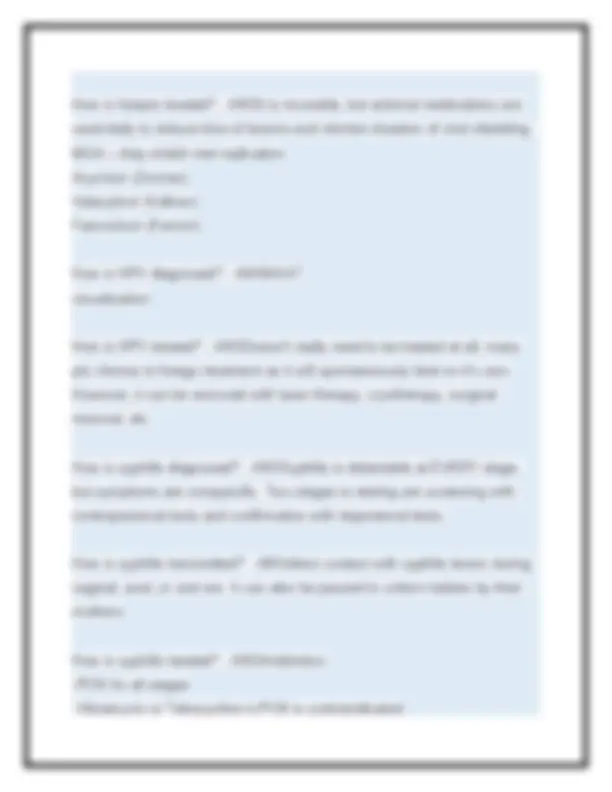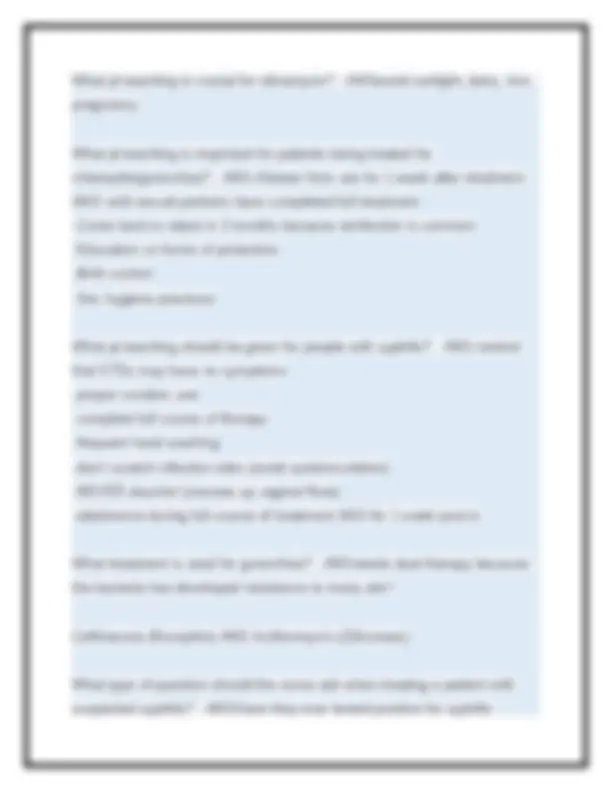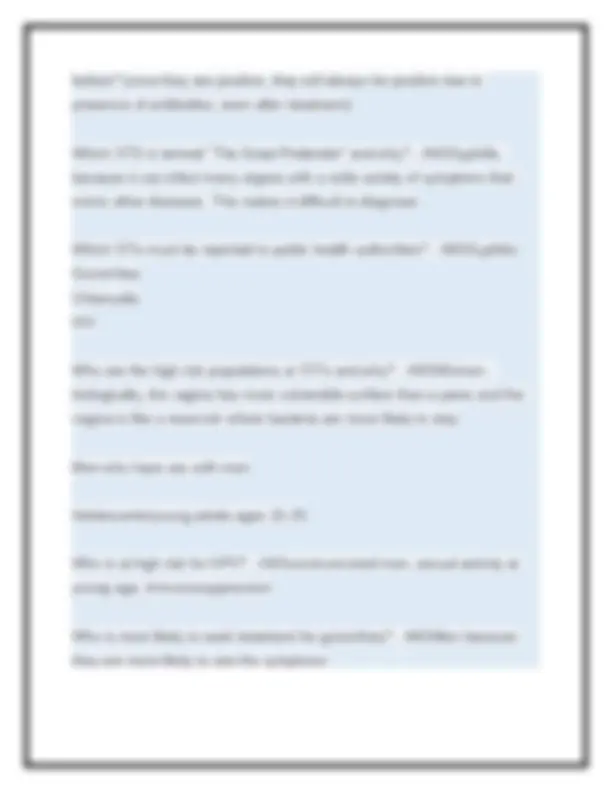







Study with the several resources on Docsity

Earn points by helping other students or get them with a premium plan


Prepare for your exams
Study with the several resources on Docsity

Earn points to download
Earn points by helping other students or get them with a premium plan
Community
Ask the community for help and clear up your study doubts
Discover the best universities in your country according to Docsity users
Free resources
Download our free guides on studying techniques, anxiety management strategies, and thesis advice from Docsity tutors
RNSG 1247 STI's (ACC Nursing Level 2) Questions and Correct Answers Updated 2025 Rated A
Typology: Exams
1 / 9

This page cannot be seen from the preview
Don't miss anything!






Describe the late (tertiary) stage of syphilis. - ANSThis is a very rare stage of syphilis. It occurs 1-20 years after initial infection. It is noncontagious, but is usually fatal. It is characterized by multisystem deterioration and gumma ulcers. In the cardiovascular system, it causes aneurysms, heart failure, and heart valve insufficiency. It can also invade the nervous system and cause HA, personality changes, slurred speech, dementia, loss of muscle coordination, tremors, paresthesias, or paralysis. Ocular syphilis can cause decreased visual acuity or permanent blindness. Describe the latent stage of syphilis? - ANSOccurs weeks to years after initial infection. It is contagious until the pt hits the one year mark, and then it is no longer contagious. It can last a lifetime or progress to the late stage. This phase has NO symptoms, but is silently doing damage to internal organs. It can be treated here to prevent further damage. Describe the primary stage of syphilis - ANSOccurs 21 days after inoculation, and pts are HIGHLY infectious during this time.
It lasts 3-6 weeks, and is characterized by chancres and enlarged lymph nodes. It is curable with PCN, but will progress to next stage if not treated. Describe the secondary stage of syphilis - ANSOccurs at 6 weeks or more, after the chancres from the primary stage are healed. Pts are still highly infectious during this stage. It lasts 1-2 years, and is characterized by a bilateral, systemic, non-itchy rash on trunk, extremities, palms, and soles of feet. Other manifestations include mucous patches in the mouth/cervix, Condylomata lata (moist papules in anogenital area), weight loss, and hair loss. It is curable with PCN, but will progress to next stage if not treated Explain recurrent genital herpes. - ANSOccurs in 50-80% of pts in the following year; s/s are less severe and heal quicker; triggered by stress, fatigue, illness, sunburn, menstruation How are STI's spread? - ANSBlood/blood products skin to skin How is herpes diagnosed? - ANSVisualizing the lesions and NAAP How is herpes transmitted? - ANSThrough direct contact with skin/mucous membranes when an infected person is or is not shedding
How many Americans are currently infected with STIs? - ANSvery common
What are the complications of HPV? - ANScervical/anal cancer What are the s/s of HPV? - ANSUsually no symptoms!! Flesh colored growths that can form into a cauliflower-like mass located on genitals, inner thighs, cervix, vagina itching, bleeding with defecation/urination may occur depending on location of warts What are the signs and symptoms of Chlamydia? - ANSMen = urethral discharge, dysuria, swollen/tender testicles Women = purulent vaginal discharge, bleeding, pain with intercourse, dysuria, cervical redness What are the signs and symptoms or gonorrhea? - ANSMen = urethral discharge, dysuria, swollen/tender testicles Women = most are asymptomatic! Increased vaginal discharge, frequent peeing, dysuria, cervical redness What are treponemal tests? - ANSTests that detect specific anti- treponemal antibodies to confirm a syphilis diagnosis. Two types are FTA-Abs and TP-PA What diagnostic tests are used to diagnose chlamydia/gonorrhea? - ANSH&P NAAT
What is the most common site for MEN associated with chlamydia/gonorrhea? For women? - ANSmen = urethra women = cervix What is the most common STI in the USA? Second most common? - ANSChlamydia = 1st Gonorrhea = 2nd What is the prodromal stage of herpes? - ANSStage where no lesions are present, but asymptomatic shedding is occurring. There will be burning, itching, or tingling at the site. What is the symptomatic stage of herpes? - ANSStage where small vesicles appear on genitals, vagina, cervix, perineum, and perianal area. Vesicles will develop into ulcers that will heal in 3 weeks without treatment. HSV is highly transmissible in this stage, and auto-inoculation can occur. What is used as treatment for chlamydia? - ANSAzithromycin (Zithromax) or Doxycycline (Vibramycin) What pt teaching is advised for HPV patients? - ANSrecurrences and reinfection are possible careful long-term follow up is advised Gardasil vaccine to prevent cervical cancer even after being infected!
What pt teaching is crucial for vibramycin? - ANSavoid sunlight, dairy, iron, pregnancy What pt teaching is important for patients being treated for chlamydia/gonorrhea? - ANS-Abstain from sex for 1 week after treatment AND until sexual partners have completed full treatment -Come back to retest in 3 months because reinfection is common -Education on forms of protection -Birth control -Sex hygiene practices What pt teaching should be given for people with syphilis? - ANS-remind that STDs may have no symptoms -proper condom use -complete full course of therapy -frequent hand washing -don't scratch infection sites (avoid autoinoculation) -NEVER douche! (messes up vaginal flora) -abstinence during full course of treatment AND for 1 week post tx What treatment is used for gonorrhea? - ANSneeds dual therapy because the bacteria has developed resistance to many abx! Ceftriaxone (Rocephin) AND Azithromycin (Zithromax) What type of question should the nurse ask when treating a patient with suspected syphilis? - ANSHave they ever tested positive for syphilis